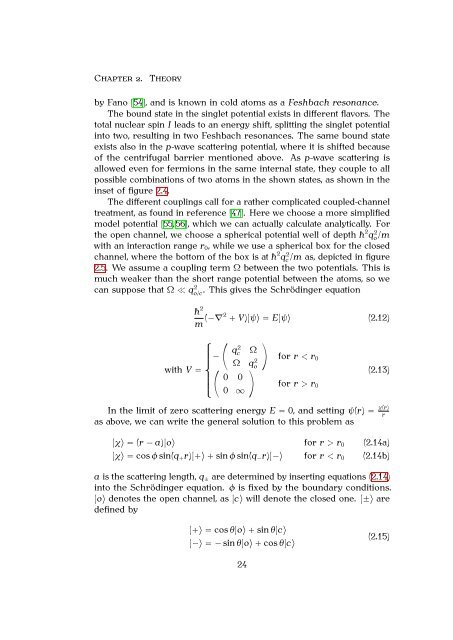Martin Teichmann Atomes de lithium-6 ultra froids dans la ... - TEL
Martin Teichmann Atomes de lithium-6 ultra froids dans la ... - TEL
Martin Teichmann Atomes de lithium-6 ultra froids dans la ... - TEL
Create successful ePaper yourself
Turn your PDF publications into a flip-book with our unique Google optimized e-Paper software.
CHAPTER 2. THEORY<br />
by Fano [54], and is known in cold atoms as a Feshbach resonance.<br />
The bound state in the singlet potential exists in different f<strong>la</strong>vors. The<br />
total nuclear spin I leads to an energy shift, splitting the singlet potential<br />
into two, resulting in two Feshbach resonances. The same bound state<br />
exists also in the p-wave scattering potential, where it is shifted because<br />
of the centrifugal barrier mentioned above. As p-wave scattering is<br />
allowed even for fermions in the same internal state, they couple to all<br />
possible combinations of two atoms in the shown states, as shown in the<br />
inset of figure 2.4.<br />
The different couplings call for a rather complicated coupled-channel<br />
treatment, as found in reference [47]. Here we choose a more simplified<br />
mo<strong>de</strong>l potential [55, 56], which we can actually calcu<strong>la</strong>te analytically. For<br />
the open channel, we choose a spherical potential well of <strong>de</strong>pth ¯h 2 q2 o/m<br />
with an interaction range r0, while we use a spherical box for the closed<br />
channel, where the bottom of the box is at ¯h 2 q2 c/m as, <strong>de</strong>picted in figure<br />
2.5. We assume a coupling term Ω between the two potentials. This is<br />
much weaker than the short range potential between the atoms, so we<br />
can suppose that Ω ≪ q2 o/c . This gives the Schrödinger equation<br />
¯h 2<br />
m (−∇2 + V)|ψ〉 = E|ψ〉 (2.12)<br />
⎧<br />
�<br />
q2 c Ω<br />
Ω q2 o<br />
⎪⎨ −<br />
with V = �<br />
0<br />
⎪⎩<br />
0<br />
�<br />
0<br />
∞<br />
�<br />
for r < r0<br />
for r > r0<br />
(2.13)<br />
In the limit of zero scattering energy E = 0, and setting ψ(r) = χ(r)<br />
r<br />
as above, we can write the general solution to this problem as<br />
|χ〉 = (r − a)|o〉 for r > r0 (2.14a)<br />
|χ〉 = cos φ sin(q+r)|+〉 + sin φ sin(q−r)|−〉 for r < r0 (2.14b)<br />
a is the scattering length, q± are <strong>de</strong>termined by inserting equations (2.14)<br />
into the Schrödinger equation. φ is fixed by the boundary conditions.<br />
|o〉 <strong>de</strong>notes the open channel, as |c〉 will <strong>de</strong>note the closed one. |±〉 are<br />
<strong>de</strong>fined by<br />
|+〉 = cos θ|o〉 + sin θ|c〉<br />
|−〉 = − sin θ|o〉 + cos θ|c〉<br />
24<br />
(2.15)

















